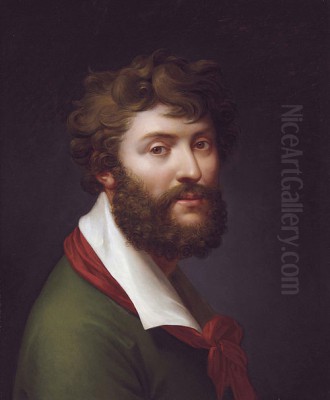
Jean-Baptiste Regnault stands as a significant, if sometimes overshadowed, figure in the landscape of late 18th and early 19th-century French art. A contemporary and, at times, a rival to the colossus Jacques-Louis David, Regnault carved out his own distinct niche within the Neoclassical movement, infusing it with a sensuousness and dynamism that occasionally hinted at the burgeoning Romanticism. His career spanned a tumultuous period in French history, from the Ancien Régime through the Revolution, the Napoleonic Empire, and the Bourbon Restoration, and his art reflects the shifting aesthetic and political tides of his era.
Early Life and Artistic Awakening
Born in Paris on October 9, 1754, Jean-Baptiste Regnault's early life was unconventional for an aspiring artist of his time. He spent a significant portion of his childhood at sea, an experience that, while not directly informing his later classical subjects, perhaps instilled in him a sense of adventure and a broader worldview. His innate artistic talent did not go unnoticed for long. By the age of fifteen, his abilities had captured the attention of a patron, Monsieur de Monval, who recognized the young man's potential.
Understanding the importance of classical training, Monval facilitated Regnault's journey to Italy, the crucible of Neoclassical inspiration. There, he was placed under the tutelage of the painter Jean Bardin. Bardin, himself a history painter, would have introduced Regnault to the masterpieces of the Italian Renaissance and the antiquities of Rome, laying the foundational understanding of form, composition, and classical narrative that would define his career. This period in Italy was crucial, immersing him in the artistic currents that were championing a return to the perceived purity and moral clarity of Greco-Roman art, a reaction against the perceived frivolity of the Rococo style, exemplified by artists like Jean-Honoré Fragonard and François Boucher.
The Path to Prominence: Rome and the Academy
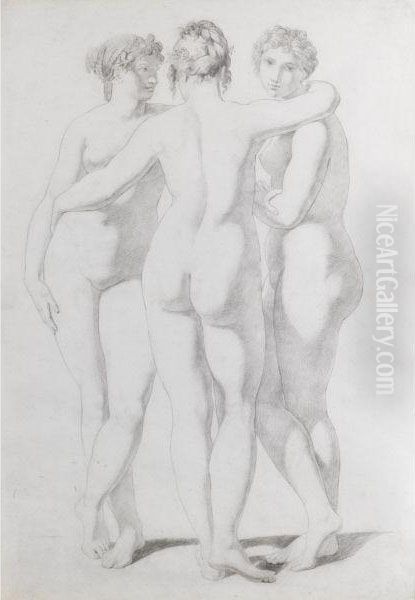
Regnault's formal artistic education continued upon his return to Paris, where he likely frequented institutions like the Royal Free School of Drawing. His talent blossomed, and the ultimate academic accolade for a young French artist was the prestigious Prix de Rome. In 1776, Regnault achieved this distinction with his painting Alexander and Diogenes (sometimes cited as Alexander visiting Diogenes). This painting, depicting the famous encounter between the powerful Macedonian king and the ascetic philosopher, showcased his mastery of anatomical rendering, classical composition, and the ability to convey a moralizing historical narrative – all hallmarks of the Neoclassical ideal.
Winning the Prix de Rome granted Regnault an extended period of study at the French Academy in Rome, located in the Palazzo Mancini. This was an invaluable opportunity to further absorb the lessons of antiquity and the High Renaissance masters, such as Raphael and Michelangelo, and to interact with other promising artists. During his time in Rome, he would have been acutely aware of the work of other prominent French artists also absorbing Italian influences, perhaps encountering figures like Joseph-Marie Vien, who was a key early proponent of Neoclassicism and the teacher of Jacques-Louis David. The influence of Italian Baroque masters, particularly the dramatic lighting of Caravaggio and the dynamic compositions of artists like Guido Reni or Domenichino, also left an imprint on his developing style, lending a certain theatricality to his work.
Upon his return to Paris, Regnault sought to establish his career. His talent and Roman training paved the way for his acceptance into the esteemed Royal Academy of Painting and Sculpture. In 1783, he was received as a full member (académicien), a significant achievement that officially recognized his status within the French art establishment. His reception piece for the Academy was likely a work that demonstrated his full command of the Neoclassical style, further solidifying his reputation.
Artistic Style and Influences
Jean-Baptiste Regnault's artistic style is firmly rooted in Neoclassicism, yet it possesses distinctive qualities. Like his contemporaries, he favored subjects drawn from Greek and Roman history and mythology, often imbued with didactic or moralizing undertones. His compositions are typically characterized by clarity, balanced arrangements, and a strong emphasis on draughtsmanship. Figures are often idealized, with smooth, polished surfaces and carefully rendered anatomy, reminiscent of classical sculpture.
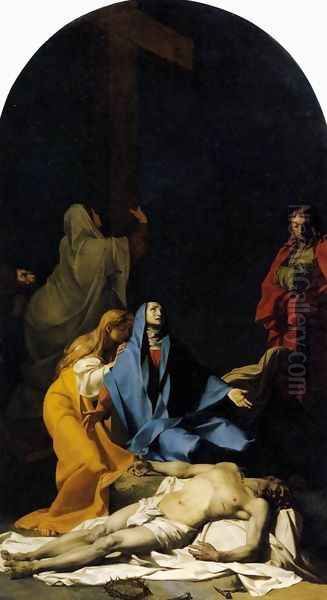
However, Regnault's Neoclassicism was often tempered with a greater sensuousness and a more dynamic use of color and light than some of his more austere contemporaries, notably Jacques-Louis David. While David's work often emphasized stoic virtue and severe linearity, Regnault's figures could exhibit a softer, more graceful quality, and his palette could be richer and more varied. There's a palpable interest in the play of light and shadow, creating a sense of volume and drama that sometimes recalls the influence of Baroque painters like Peter Paul Rubens or even Rembrandt, though filtered through a Neoclassical lens.
His works often feature complex multifigure compositions, handled with considerable skill. He was adept at conveying narrative through gesture and expression, though perhaps with less of the stark, revolutionary fervor that characterized David's major political works. Regnault's engagement with classical themes often explored the more lyrical or allegorical aspects of mythology, alongside heroic or historical episodes. The influence of earlier French classicists like Nicolas Poussin can also be discerned in the careful structuring of his compositions and the intellectual rigor underpinning his choice of subjects.
Key Masterpieces
Throughout his long and productive career, Jean-Baptiste Regnault created numerous significant works that exemplify his artistic vision. Among his most celebrated paintings is The Education of Achilles (1782), now housed in the Musée du Louvre. This work, likely his graduation piece or a major early commission, depicts the young Greek hero being instructed by the centaur Chiron. It showcases his skill in rendering both the human and mythical form, set within a classical landscape, and embodies the Neoclassical interest in themes of mentorship and the transmission of knowledge.
Another pivotal work is Socrates Tearing Alcibiades from the Embrace of Sensual Pleasure (1791). This painting tackles a complex philosophical theme: the struggle between reason and passion, virtue and vice. Socrates, the embodiment of wisdom, physically pulls the handsome youth Alcibiades away from alluring female figures representing worldly temptations. The composition is dynamic, the figures expressive, and the moral message clear, aligning perfectly with the didactic aims of Neoclassical art, particularly in the context of the French Revolution's emphasis on civic virtue.
His painting The Three Graces (1793), also in the Louvre, offers a more lyrical and sensuous interpretation of a classical subject. The three goddesses of charm, beauty, and creativity are depicted with an elegant grace and a subtle eroticism that, while still within the bounds of Neoclassical decorum, reveals Regnault's capacity for a softer, more appealing aesthetic. This work demonstrates his ability to modulate his style, moving beyond purely heroic or moralizing themes to embrace the more decorative potential of classical mythology.
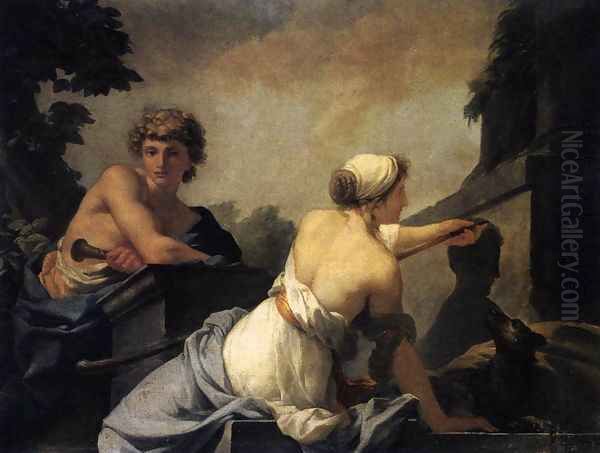
Other notable works include The Descent from the Cross, showcasing his ability to handle traditional religious subjects with Neoclassical gravity, and The Origin of Painting (or Dibutades Tracing the Portrait of Her Shepherd), which explores a popular myth about the beginnings of art itself. Pygmalion Praying to Venus to Animate His Statue is another example of his engagement with Ovidian myths, focusing on the transformative power of art and love. These works, varied in subject but consistent in their skilled execution, cemented Regnault's reputation as a leading painter of his generation.
A Rivalry and a Legacy: Regnault and David
No discussion of Jean-Baptiste Regnault can be complete without addressing his relationship with Jacques-Louis David (1748-1825). David was the undisputed leader of the Neoclassical school in France, a towering figure whose artistic and political influence was immense, especially during the French Revolution and the Napoleonic era. Regnault and David were contemporaries, and inevitably, a degree of professional rivalry existed between them and their respective ateliers (studios).
While both artists championed the Neoclassical style, their interpretations differed. David's art was often more overtly political, characterized by a severe, almost austere grandeur, as seen in works like The Oath of the Horatii or The Death of Marat. Regnault's Neoclassicism, while equally committed to classical ideals, often displayed a greater suppleness, a richer palette, and a more pronounced sensuality. This distinction led to the formation of two somewhat distinct "schools" or followings within the broader Neoclassical movement. Art critics and connoisseurs of the time often compared their works, sometimes favoring one over the other based on prevailing tastes or political allegiances.
Despite the rivalry, the presence of such strong, distinct talents undoubtedly enriched the artistic environment of Paris. The competition spurred innovation and pushed artists to refine their skills and articulate their unique visions. While David's historical shadow is longer, Regnault maintained a highly successful career, receiving numerous commissions and accolades, and his studio was a significant training ground for the next generation of artists. His approach offered an alternative, perhaps more accessible, vision of Neoclassicism that appealed to a wide range of patrons.
The Teacher and His Pupils
Like many prominent artists of his time, Jean-Baptiste Regnault was an influential teacher, heading a large and productive studio. His role as an educator was crucial in disseminating Neoclassical principles and shaping the future of French painting. He trained a considerable number of artists, some of whom went on to achieve significant recognition themselves.
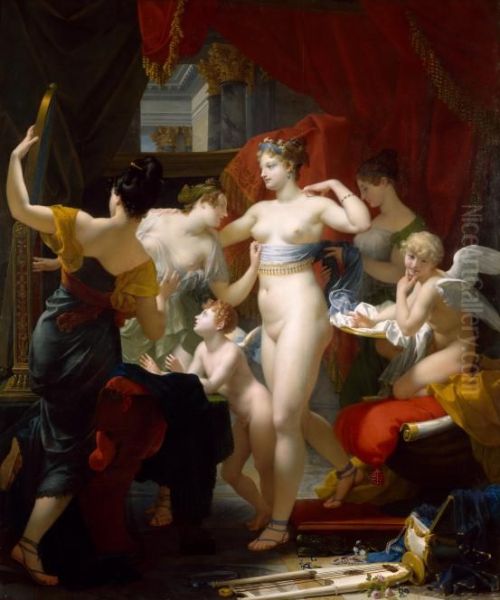
Among his most notable pupils was Pierre-Narcisse Guérin (1774-1833). Guérin became a key figure in his own right, a painter whose style bridged the gap between the late Neoclassicism of Regnault and David and the emerging Romantic movement. Guérin, in turn, would become an even more influential teacher, numbering among his own students such seminal Romantic figures as Théodore Géricault and Eugène Delacroix. Thus, Regnault's pedagogical influence extended indirectly but powerfully into the heart of the Romantic revolution, even if his own style remained more firmly rooted in classicism.
Other students of Regnault included figures like Merry-Joseph Blondel, Louis Hersent, Charles-Paul Landon (also an art historian and critic), and numerous others who populated the Salons and fulfilled commissions throughout the early 19th century. His teaching would have emphasized rigorous academic training: drawing from casts and live models, studying anatomy, and mastering the principles of perspective and composition. He would have also guided them in the selection and interpretation of historical and mythological subjects. The success of his atelier attests to his reputation as a skilled and respected master. The influence of his teaching can also be seen in the work of artists like Alexis-Louis Charles Arthur Gouin and Alexandre de La Vallée, who passed through his studio.
Navigating a Turbulent Era
Regnault's career unfolded against the backdrop of some of the most dramatic events in French history. He witnessed the decline of the Ancien Régime, the fervor and terror of the French Revolution, the rise and fall of Napoleon Bonaparte, and the subsequent Bourbon Restoration. These political upheavals profoundly impacted the art world, shifting patronage systems, dictating subject matter, and influencing artistic styles.
During the Revolution, there was a strong demand for art that promoted republican virtues and celebrated heroic deeds from Roman history, themes that aligned well with Regnault's Neoclassical training. He continued to exhibit at the Salons, adapting to the changing political climate. After the Revolution, during the Napoleonic Empire, artists were often called upon to glorify the Emperor and his military victories. While David became Napoleon's First Painter, other artists like Regnault also contributed to the artistic production of the era, though perhaps with less direct political engagement than David or Antoine-Jean Gros, who specialized in Napoleonic battle scenes.

Regnault also played a role in the institutional life of the arts. Following the Revolution, he was involved in art committees, some of which were tasked with important responsibilities such as the conservation and inventory of artworks, including those confiscated from the aristocracy and the Church. This involvement demonstrates his respected position within the artistic community and his commitment to the preservation of France's cultural heritage. His adaptability allowed him to continue working and maintaining his status through these successive regimes, a testament to his artistic skill and perhaps his diplomatic acumen. He was made a Baron of the Empire in 1808 and a Chevalier of the Legion of Honour.
Later Years and Enduring Influence
Jean-Baptiste Regnault continued to paint and exhibit into his later years. While the dominant artistic trends began to shift towards Romanticism in the early 19th century, with artists like Géricault and Delacroix (both linked to his student Guérin) capturing the public imagination, Regnault remained largely faithful to his Neoclassical roots, albeit a version of it that was often more painterly and less severe than its earlier manifestations.
His later works might show a continued interest in mythological and allegorical subjects, executed with the technical proficiency he had honed over decades. He held professorships at the École des Beaux-Arts, further cementing his role as an elder statesman of the French art world. He would have witnessed the rise of artists like Jean-Auguste-Dominique Ingres, a staunch defender of classical principles who, in some ways, carried the Neoclassical torch into the mid-19th century, though Ingres himself had been a student of David. Regnault's contemporaries also included figures like Pierre-Paul Prud'hon, whose style offered a softer, more melancholic classicism, and Anne-Louis Girodet-Trioson, another of David's pupils who developed a highly individual, often pre-Romantic style.
Jean-Baptiste Regnault passed away in Paris on November 12, 1829, at the age of 75, reportedly from pneumonia. By the time of his death, the artistic landscape was already transforming, but his contributions to French Neoclassicism were undeniable. He had produced a substantial body of work, trained a generation of artists, and offered a distinct and influential interpretation of classical ideals.
Conclusion: A Refined Classicist
Jean-Baptiste Regnault's legacy is that of a highly skilled and influential painter who played a crucial role in French Neoclassicism. While often compared to his more famous contemporary, Jacques-Louis David, Regnault developed a personal style characterized by technical brilliance, a sophisticated understanding of classical sources, and a sensuousness that distinguished his work. His paintings, from grand historical narratives like Alexander and Diogenes and Socrates Tearing Alcibiades from the Embrace of Sensual Pleasure to more lyrical compositions like The Three Graces and The Education of Achilles, demonstrate the breadth of his talent.
As a respected teacher, his influence extended to prominent artists like Pierre-Narcisse Guérin, and through him, indirectly to the pioneers of Romanticism. He successfully navigated the treacherous political waters of his time, maintaining a prominent position in the French art world for decades. Today, his works are held in major museums, including the Louvre, and he is recognized as a key figure who, alongside artists like Joseph-Marie Vien, Jean-François-Pierre Peyron, and François Gérard, helped define an era of profound artistic and social change, leaving an indelible mark on the history of French art. His ability to blend classical rigor with a more approachable, often graceful aesthetic ensures his enduring importance.